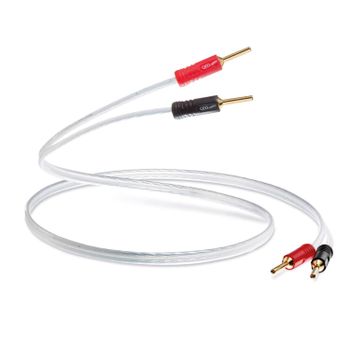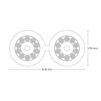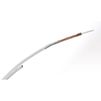QED XT25 Speaker Cable - 2m Pair
Product code: QE1460
Product features
- Pre-Terminated Speaker Cable Pair
- 2m Length, X-Tube Technology
- 99.999% Oxygen Free Copper
- Low-Loss Dielectric
- Low DC Resistance
Dimensions
- Width: 2000mm
The QED speaker cable story began in 1973, with the launch of the world's first specialist speaker cables, QED 42 and 79 strand, now household names in the audio industry.
Building on this longstanding British speaker cable heritage, QED embarked on an exhaustive research program into cable parameters which began in 1995 and continues into 2017 with the release of “The Sound of Science”, a 40 page White Paper distilling the research published since 1973 by QED. These reports set out the “top down” design-principles that have resulted most recently in the development of QED XT25 loudspeaker cable – the new class leading standard in budget to mid-range speaker cables.
X-Tube Technology
In loudspeaker cables high pitched sounds are forced to travel towards the outside of the conductor and so are able to use less of the available cross-sectional area as the pitch increases. It means that for high frequencies the resistance of the cable appears to be much higher than it does for lower pitched sounds. The XT25 variation of QED X-Tu Insulation LDPE jacket with 100% coverage of Aluminium Mylar tape wrap Plugs and spades QED Airloc Forte banana plugs. Technology solves these problems by creating a hollow tubular conductor geometry out of individual conductor bunches through which each frequency can pass with equal ease when compared to traditional solid or stranded conductors.
99.999% Oxygen-Free Copper
Speaker cables need to have a large current carrying capacity. If the electrical resistance of the cable is too large, part of the music signal will be lost, causing a detrimental effect on the fidelity of the sound you hear. To stop this from happening we make the resistance of our speaker cables as small as possible. We do this by using the largest practical cross-sectional area of copper within the size constraints of each cable. In order to squeeze the last drop of performance from the conductors we make sure that there are no impurities in the copper which would defeat the object of making them so large. That’s why we use 99.999% oxygen-free copper exclusively.
Low-Loss Dielectric
It is not generally appreciated that the electrical signals moving at or near the speed of light in a wire do so via the medium of electromagnetic (EM) waveforms which exist within the dielectric which surrounds the conductors as well as within the conductors themselves. The movement of electrons along the conductor merely facilitates generation of the EM waveform as their “drift velocity” is only a few centimetres per second. It is therefore important to ensure that the dielectric material used to insulate and protect the central conductors of the speaker cable is of a type which “permits” the establishment of EM waveforms without appreciable loss.
Low DC Resistance
At QED we recognise that low d.c. resistance of the loudspeaker cable is of paramount importance for high-fidelity signal transfer. This is because the speaker presents a frequency dependent load to the amplifier of which the cable forms a variable proportion. If resistance is allowed to be too large then audible changes to the frequency response characteristics of the loudspeaker will be introduced which cannot be corrected for by the amplifier’s negative feedback loop.
Specifications:
- Cross- Sectional Area - 25 mm2
- Wire Gauge - 14 AWG
- Jacket Outside Diameter - 3.96 mm
- Loop Resistance - 13.4 mΩ/m
- Capacitance - 35.0 pF/m
- Loop inductance - 0.52 μH/m
- Dissipation Factor - @ 10 kHz 0.0001
- Conductors - 10 x 19/0.13 mm
- Insulation - LDPE jacket with 100% coverage of Aluminium Mylar tape wrap
- Plugs And Spades - QED Airloc Forte banana plugs
| File | Name |
|---|
The QED speaker cable story began in 1973, with the launch of the world's first specialist speaker cables, QED 42 and 79 strand, now household names in the audio industry.
Building on this longstanding British speaker cable heritage, QED embarked on an exhaustive research program into cable parameters which began in 1995 and continues into 2017 with the release of “The Sound of Science”, a 40 page White Paper distilling the research published since 1973 by QED. These reports set out the “top down” design-principles that have resulted most recently in the development of QED XT25 loudspeaker cable – the new class leading standard in budget to mid-range speaker cables.
X-Tube Technology
In loudspeaker cables high pitched sounds are forced to travel towards the outside of the conductor and so are able to use less of the available cross-sectional area as the pitch increases. It means that for high frequencies the resistance of the cable appears to be much higher than it does for lower pitched sounds. The XT25 variation of QED X-Tu Insulation LDPE jacket with 100% coverage of Aluminium Mylar tape wrap Plugs and spades QED Airloc Forte banana plugs. Technology solves these problems by creating a hollow tubular conductor geometry out of individual conductor bunches through which each frequency can pass with equal ease when compared to traditional solid or stranded conductors.
99.999% Oxygen-Free Copper
Speaker cables need to have a large current carrying capacity. If the electrical resistance of the cable is too large, part of the music signal will be lost, causing a detrimental effect on the fidelity of the sound you hear. To stop this from happening we make the resistance of our speaker cables as small as possible. We do this by using the largest practical cross-sectional area of copper within the size constraints of each cable. In order to squeeze the last drop of performance from the conductors we make sure that there are no impurities in the copper which would defeat the object of making them so large. That’s why we use 99.999% oxygen-free copper exclusively.
Low-Loss Dielectric
It is not generally appreciated that the electrical signals moving at or near the speed of light in a wire do so via the medium of electromagnetic (EM) waveforms which exist within the dielectric which surrounds the conductors as well as within the conductors themselves. The movement of electrons along the conductor merely facilitates generation of the EM waveform as their “drift velocity” is only a few centimetres per second. It is therefore important to ensure that the dielectric material used to insulate and protect the central conductors of the speaker cable is of a type which “permits” the establishment of EM waveforms without appreciable loss.
Low DC Resistance
At QED we recognise that low d.c. resistance of the loudspeaker cable is of paramount importance for high-fidelity signal transfer. This is because the speaker presents a frequency dependent load to the amplifier of which the cable forms a variable proportion. If resistance is allowed to be too large then audible changes to the frequency response characteristics of the loudspeaker will be introduced which cannot be corrected for by the amplifier’s negative feedback loop.
Specifications:
- Cross- Sectional Area - 25 mm2
- Wire Gauge - 14 AWG
- Jacket Outside Diameter - 3.96 mm
- Loop Resistance - 13.4 mΩ/m
- Capacitance - 35.0 pF/m
- Loop inductance - 0.52 μH/m
- Dissipation Factor - @ 10 kHz 0.0001
- Conductors - 10 x 19/0.13 mm
- Insulation - LDPE jacket with 100% coverage of Aluminium Mylar tape wrap
- Plugs And Spades - QED Airloc Forte banana plugs




